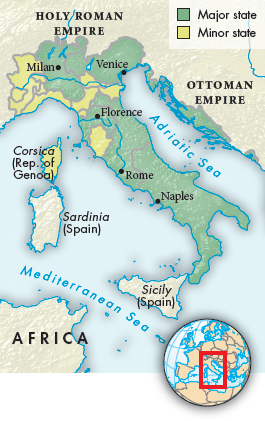Understanding World Societies:
Printed Page 422
Wealth and Power in Renaissance Italy
Economic growth laid the material basis for the Italian Renaissance and its cultural achievements. Ambitious merchants gained political power to match their economic power and then used their money to buy luxuries and hire talent in a patronage system. Through this system, cities, groups, and individuals commissioned writers and artists to produce specific works. Thus economics, politics, and culture were interconnected.

The Renaissance began in the northern Italian city of Florence, which possessed enormous wealth as a consequence of its domination of European banking. Banking profits allowed elite families to control the city’s politics and culture. Although Florence was officially a republic, starting in 1434 the great Medici (MEH-
In other Italian cities as well, wealthy merchants and bankers built magnificent palaces and became patrons of the arts, hiring not only architects to design and build these palaces but also artists to fill them with paintings and sculptures, and musicians and composers to fill them with music. Attractions like these appealed to the rich, social-
This cultural flowering took place amid political turmoil. In the fifteenth century five powers dominated the Italian peninsula: Venice, Milan, Florence, the Papal States, and the kingdom of Naples. These powers competed furiously for territory and tried to extend their authority over smaller city-
This division facilitated outside invasions of Italy. These began in 1494 as Italy became the focus of international ambitions and the battleground of foreign armies, and Italian cities suffered severely from continual warfare for decades. Thus the failure of the city-